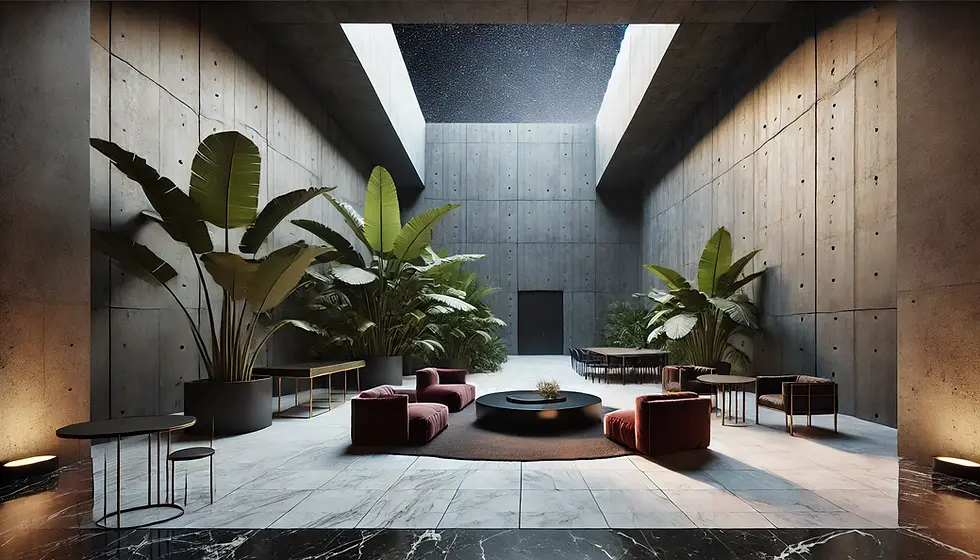The Importance of Interior Decoration in the Living Space
- Orhan Guliyev

- Jun 25, 2024
- 3 min read
Interior decoration is pivotal in enhancing the quality of life by transforming living spaces into personalized sanctuaries.

A well-decorated home is not just about aesthetics; it's about creating a functional, comfortable, and inspiring environment.
In this blog post, we'll delve into the critical aspects of interior decoration, including space planning, furniture selection, layout, color scheme, textures, patterns, materials, lighting design, architectural features, elements of nature, and window treatments.
Space Planning: The Foundation of Interior Decoration and Design
Efficient space planning is crucial for achieving successful interior design.

This includes organizing furniture and decorations to optimize functionality and comfort while maintaining a seamless transition between different areas. In the same way, careful space planning can create a sense of openness and warmth even in compact areas.
It's essential to consider each room's intended use and how individuals will navigate through it.
Furniture Selection: Balancing Form and Function
When designing a living space, it is essential to carefully consider the furniture choices.
The correct furniture improves a room's appearance and adds to its usefulness.

It is crucial to select quality furniture that harmonizes with the style of your home, acting as a focal point in the room.
Size, shape, and color should be evaluated to assure the furniture fits well within the space and meets the occupants' needs.
Additionally, it is crucial to consider ergonomics, especially when choosing frequently used pieces such as sofas, chairs, and beds.
Layout: Creating Harmony and Balance
When arranging a room, the layout is critical in influencing its atmosphere and usability.

A thoughtfully designed layout aims to achieve harmony among all elements, resulting in a cohesive and balanced appearance.
It's essential to consider a combination of symmetrical and asymmetrical arrangements to introduce visual interest while maintaining equilibrium.
Focal points should be carefully emphasized, and clear and logical pathways should be established to ensure a well-functioning space.
Color Scheme: Setting the Mood
Color selection can significantly affect our emotions and establish the ambiance of any space.

Thoughtfully chosen color combinations can create a sense of tranquility and relaxation or evoke a feeling of liveliness and vigor. When selecting colors for a room, it's essential to consider its intended purpose, the amount of natural light it receives, and the atmosphere you wish to establish. Feel free to explore bold colors and unconventional combinations to introduce an element of surprise and visual impact to your environment.
Textures and Patterns: Adding Depth and Interest
Integrating different textures and patterns can bring dimension and intrigue to a space.

Textures encompass a wide range, from plush fabrics like velvet and silk to sturdier materials like wood and metal. Whether geometric, floral, or abstract, patterns inject vibrancy and individuality into a room. Skillfully combining textures and patterns can produce a sophisticated, multi-dimensional aesthetic that offers coziness and personality.
Materials: Choosing Wisely
When choosing materials for interior decoration, it's essential to consider aesthetics and practicality.

Natural materials (wood, stone, leather) can lend a timeless appeal to your décor, while modern options like glass and metal provide a more contemporary look.
Using sustainable materials is also gaining prominence as we endeavor to create more environmentally friendly living spaces.
Basic Light Design: Illuminating Your Space
Lighting can significantly transform a room's ambiance and atmosphere.

You can create a versatile and practical living space by incorporating ambient, task, and accent lighting.
While natural light is ideal, artificial lighting resembling natural daylight is a great alternative.
Additionally, dimmers allow us to adjust the lighting output according to the time of day or specific activities, helping to set the desired mood.
Architectural Features: Enhancing the Structure
"Architectural elements such as moldings, fireplaces, and built-in shelving can bring personality and value to a home.

Emphasizing these features through strategic decoration can elevate the overall visual appeal of the living space. If your home doesn't have unique architectural details, you can introduce them by incorporating decorative elements like crown molding, wainscoting, or customized cabinetry."
Elements of Nature: Bringing the Outdoors In
Bringing natural elements into your interior decor can help create a peaceful and contented atmosphere.

Adding plants, water features, and using natural materials such as timber and stone can carry the beauty of the outdoors into your home. These elements help to create a harmonious and balanced environment, encouraging relaxation and a deeper connection with nature."
Window Treatments: Finishing Touches
Window treatments contribute to a space's functionality by providing privacy and light control and adding aesthetic value.

It's essential to select window treatments that harmonize with the overall design theme, such as modern blinds, elegant drapes, or light and uncomplicated curtains.
Conclusion
Interior decoration goes beyond simply arranging furniture and selecting colors.

It's about crafting a space that mirrors your personality and enriches your lifestyle.
You can design a functional and stunning living space by carefully considering space planning, furniture selection, layout, color schemes, textures, and other essential elements.





Comments